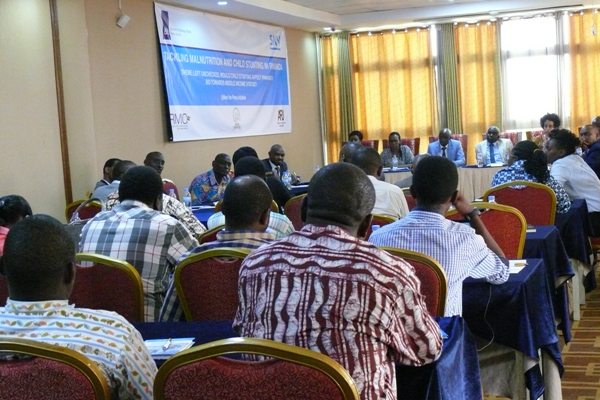
By Jejje Muhinde Muhamudu;
Different stakeholders including government, development partners and civil society organizations have called for multi-sectoral approach collaboration, and coordination in the fight to eradicate stunting and malnutrition in Rwanda.
The call was made during a meet the press discussions title “Left Unchecked, Would Child Stunting and Malnutrition Affect Rwanda’s Bid Towards middle Income Status.”
The initiative organized by Rwanda Development Organisation (RDO) in partnership with SNV’s project on nutrition called Voice for Change Partnership (V4CP) was held on Wednesday at Lemigo Hotel and coordinated by Rwanda Media Commission (RMC).
Eugene Rwibasira, the Executive Secretary of RDO underlined that stunting impedes cognitive development, education, attainment and life time earnings. It also deprives the economy of quality human capital that is critical to attain Rwanda’s development aspirations and sustain its economic gains.
He said that, despite policy strategies in place, a lot remain to done to achieve the targets in reducing stunting and malnutrition.

According to Dr. Innocent Turate, from the Ministry of Health, collaboration is required by all the different stakeholder to eradicate stunting and also called for community-based efforts for a follow-up by health officers at health centres.
Emmanuel Niyongira, the director of V4CP called for agricultural sensitization and nutritional crop production to be implemented if stunting and malnutrition targets are to be achieved by 2024.
He encouraged all Rwandans to work together to end child malnutrition and stunting, explaining that implementation of anti-malnutrition programs require collective efforts.
The media was urged to increase efforts aimed at teaching citizens about keeping hygiene and doing family planning because of they are some of the factors that cause stunting.
Stakeholders also said that without serious measures to promote family planning many parents will continue to struggle to get enough to feed their children, a factor that may worsen child malnutrition.
Other programs on which the government banks to find solutions to the thorny issue of malnutrition is strengthening the one-cow-per-poor-family program under which poor parents would get milk for their children and getting community health workers to coach parents on how to prepare a decent meal for children as well as how to keep appropriate hygiene for food consumption.
According to domestic government financing, the nutritional budget was at 3.6 percent in 2019, while in 2018 was at 3.8 percent according to this fiscal year 2019-2020 it is 4.2 percent.
